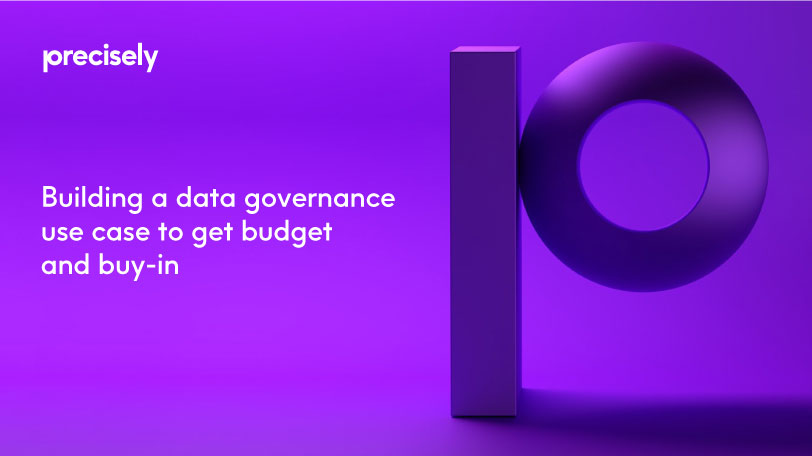eBook
Building a Data Governance Use Case to Get Budget and Buy-in
Read this eBook to learn how you can generate support, secure budget, and gather momentum to build a data governance framework.
The case for data governance
- Data today represents a valuable organizational asset and the key to business development and competitive differentiation.
- As organizations amass data, they must ensure it is accurate and reliable, and understand where it’s located, where it came from and how it’s used.
- Data governance is a strategy of people, processes and technology to mitigate risk and maximize data value.
- In the past, many organizations had little to no formalized governance. But companies today need an enterprise approach to ensure high quality, well managed data assets.
- Data governance is becoming an imperative; those without it will flounder or fail to capitalize on business opportunity.
- Governance needs to be business-driven and quality-focused to achieve critical enterprise objectives and deliver ROI.
But how do you generate support, secure budget and gather momentum to build a data governance framework?
You build a business case.


Why build a quality-focused data governance business case?
A common obstacle to data governance is gaining buy-in.
Not just from executives, but from across the organization – from every stakeholder who needs to contribute to make it successful.
And the value of data governance can really be felt if it’s tied to a revenue- generating initiative.
A business case needs to:
- Evangelize the enterprise-wide benefits of governance.
- Provide demonstrable ROI by attaching data quality to your governance initiative, including reduced cost and risk, increased revenue, compliance and more.
- Include a detailed cost/benefit analysis.
- Encourage advocacy for the initiative.
- Outline goals and project long-term impact.
- Promote enterprise-wide communication.
What is the value of a business case?
The downfalls of not creating a data governance business case:
- Misunderstood data challenges.
- Executive leadership will likely defer until there’s a financial impact or upside, such as regulatory penalties or a link between governance and a revenue-driving initiative.
- Executive leadership will likely defer until governance becomes an absolute must.
- More challenges arise as data volumes increase.
Why create a data governance business case:
- Fosters a mutual understanding of the challenges quality-powered data governance can solve.
- Identifies the technologies, business processes, resources and costs associated.
- Establishes business value and ROI.
- Determines intangible benefits.

Do you need to build a business case?
- Are you struggling to get data governance budget approval?
- Do you lack executive support?
- Do you lack support from key business and IT stakeholders?
- Do key stakeholders fail to believe their data or is data trust extremely low?
- Is data governance assigned to a single department? Is data governance siloed?
- Is there a general lack of understanding about data governance across the organization?
If the answer to any of these questions is “yes” then you likely need to build a quality-powered data governance business case.

Identifying the need for data governance
If an organization cannot answer any of the following questions, they need a data governance program:
What does the data mean?
Can I trust it?
How do I find it?
Where does the data come from?
Is it the same thing to everyone?
Who do I ask?
And building a quality powered data governance program is how you begin to answer each of these critical questions.
You need to get your data governance in gear if:
- The organization is struggling to centralize data or building a big data environment like a data lake without any data quality measures.
- The organization is facing compliance or regulatory hurdles.
- There’s a disconnect between business and IT or between lines of business due to lack of communication/collaboration.
- Business/operations are overly reliant on IT resources for all things data.
- Data tools are overly technical and difficult or impossible to understand for business operations.
- Loss or absence of key employees has negatively impacted the ability to effectively do business due to tribal/ institutional knowledge.
- The organization’s data management team spends more time fixing data quality issues than running analytics.
- Business users don’t utilize data assets because they don’t trust them, can’t find them or don’t understand them.

It’s often difficult to quantify the value of data governance, as many of the benefits are indirect. But data governance can accomplish all of the following:
- Risk management through trustworthy data and transparency into the data landscape.
- Reduce financial and reputational risks through strict regulatory compliance.
- Increase efficiency and productivity of high-value resources (i.e., IT/data management).
- Minimize data sprawl through data efficiency and duplicate data reduction.
- Increase data accuracy to generate higher quality outcomes.
- Increase data trust and utilization to generate more valuable business insights.
- Increase efficiencies through automation and machine learning.
- Reduce tribal knowledge and proliferation of data intelligence.
- Increase enterprise accountability and collaboration.
- Risk management through trustworthy data and transparency into the data landscape.
There are four key triggers for launching quality-powered data governance:
1. Core processes/operational excellence
- Data governance helps deliver quality insights that enable a company to achieve its most critical business objectives to reduce risk and increase revenue, and prioritizes critical data quality validation, balancing and reconciliation.
- Accountability and collaboration create a data-driven culture that values high quality data to produce better business insights.
2. Digital transformation/system migration
- Whether it is a core transformation project or a data lake, the need for data governance emerges before the project even kicks off.
- Data governance provides a framework to develop fast and repeatable processes for data integration, enabling data analysis and faster speed to insights.
3. Third party data
- Quality-powered data governance ensures that data remains complete, consistent and accurate regardless of its source.
- Understanding the origins and quality levels of data throughout the data supply chain means data is trusted by users and used appropriately.
4. Compliance/Risk Mitigation
- By ensuring appropriate data access, usage and accuracy, companies guard against financial and reputational risk.
- With rapidly evolving regulatory requirements, data governance establishes and maintains critical policies and processes.

The process of building a data governance business case
The business case team:
- Establish a data governance leadership team.
- A CDO or a data evangelist usually leads the team.
The technologies:
- Ideally, an integrated data platform that incorporates end-to-end data quality monitoring and analytics.
- A solution with business-friendly capabilities that empowers users and enables better data ROI.
The methodology:
- Define a data governance methodology.
- Must be repeatable and include drivers to benefit both the IT and business teams.
- Key data governance capabilities that include data catalog, business glossary, data lineage and metadata—all enabled by intuitive, drag-and-drop workflows.
Define expected outcomes:
- Clearly-defined data terms across the entire enterprise.
- Improved confidence in data among business users.
- Established roles and responsibilities among data owners, data stewards and data users.
- Improved data quality.
- Established and understood data lineage from a business standpoint.
- Increased data usage among business users.
- Improved decision-making capabilities.
- Simplified proof of regulatory compliance.
Estimate the internal labor costs:
- Define each role and estimate total hourly costs.
For example, a business analyst makes $40/hr and will need an estimated 50 hours of work to complete his or her tasks equaling about $2,000 total. A VP of technology makes $90/hr and requires an estimated 40 hours to complete his or her assignments equaling $3,600.
Estimate the cost of technology:
- The cost differential between an in-house build and an external purchase (time, money and resources).
- What is the cost of the data platform?
- What are the yearly maintenance costs?
- What are the costs of getting the platform up and running? Include time and resources.
- Are there any recurring expenses?
- Are there consultant fees?
- Do FTEs have to get trained on the new technology to be successful?
Identify the monetary benefits:
- List any tangible monetary savings.
- What are the yearly maintenance costs?
- Estimate the total financial value of the program.
- Validate with the finance team.
Gain buy-in from the executive leadership team:
- Validate tangible and intangible benefits.
- Estimate the total cost conservatively.
- Review with the business case team.
- Finalize and publish business case.
The enterprise value of quality-powered data governance
A business case should demonstrate value across an organization, to build support and reiterate the end goals of good data governance:
- Increase data value with embedded data quality enrichment
- Mitigate risk exposure
- Regulatory compliance
- Ensure proper data asset usage
- Improved data trust
- Enhanced data knowledge across the business
- Better, faster business decisions
- Greater data transparency
- Reduced costs through greater efficiency
- Faster speed to insights


Conclusion
- Compile a list of reasons data governance is a must.
- Seek input from diverging lines of business.
- Foster collaboration to engage all stakeholders.
- Put together a data governance team.
- Identify organizational needs and how data governance can help.
- Create a process and follow it.
- Use a business template to document data governance expectations.
- Secure funding and resources from executive leadership.
- Get to work on a data governance program!


